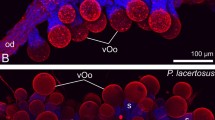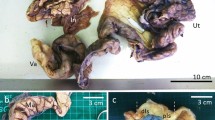Abstract
A SMALL piece of ovary of a very young pigeon was kept for about twenty minutes in a trough of dilute solution of neutral red, just pink in colour (strength—1/25000 physiological salt solution). It was then teased out and examined under an oil immersion lens in artificial light. The young oocytes showed a nucleus and a thick granular mass at one end of the nucleus in the general cytoplasm (C. F. D'Hollander's “yolk nucleus of Balbiani” observed with classical methods). In this area particularly, in more advanced oocytes, could be seen the following three structures (Fig. 1).
This is a preview of subscription content, access via your institution
Access options
Subscribe to this journal
Receive 51 print issues and online access
$199.00 per year
only $3.90 per issue
Buy this article
- Purchase on Springer Link
- Instant access to full article PDF
Prices may be subject to local taxes which are calculated during checkout
Similar content being viewed by others
Author information
Authors and Affiliations
Rights and permissions
About this article
Cite this article
BHATTACHARYA, D., DAS, R. Golgi Body and Vacuome. Nature 124, 692–693 (1929). https://doi.org/10.1038/124692b0
Issue Date:
DOI: https://doi.org/10.1038/124692b0
Comments
By submitting a comment you agree to abide by our Terms and Community Guidelines. If you find something abusive or that does not comply with our terms or guidelines please flag it as inappropriate.



